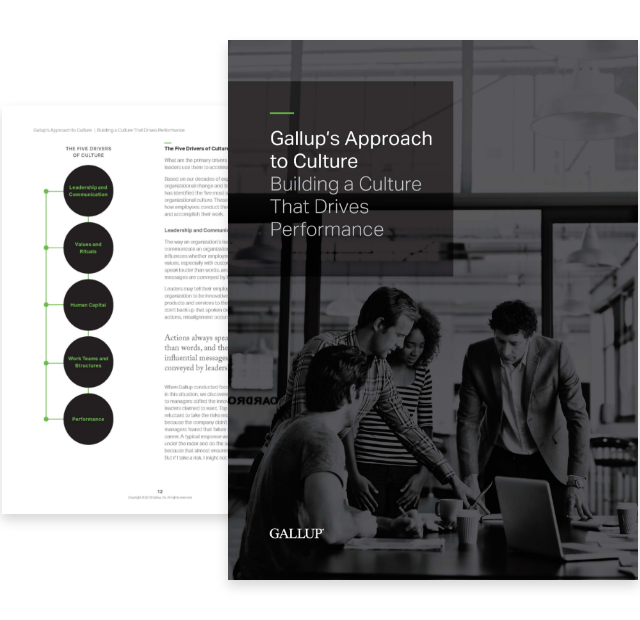
What Is Organizational Culture? And Why Does It Matter?
- What Is Organizational Culture?
- Why Is Company Culture So Important?
- How Does Leadership Influence Organizational Culture?
- What Does It Mean for a Workplace to Have a 'Toxic Culture'?
- Should Your Company Culture Match Your Brand?
- What Are the Key Drivers of a Company's Culture?
- Can Organizational Culture Change?
- Your Best Company Culture Will Be Unique
- Build Your Ideal Company Culture With Gallup
01 What Is Organizational Culture?
Few things are as important -- and sometimes as difficult to grasp -- as an organization's culture.
Prospective employees want to know what the culture is to determine whether they will "fit in." Customers want to know what to expect when they interact with employees. We all want to know where we came from, who we are and where we are going. Senior leadership wants to know what company culture is so they can use it to influence behaviors.

So, what is culture? Not surprisingly, there are many different organizational culture definitions. Some people define company culture in terms of its essential features, such as being "innovative," "performance-based" or "traditional."
Others take a dynamic view, understanding a culture definition in terms of the interplay among different forces in the organization. Both approaches view culture as a sort of invisible hand that guides and shapes an organization.
We know there are endless company culture definitions, but Gallup believes that culture simply comes down to "how we do things around here."
It should come as no surprise, then, that each organization has a unique type of culture.
Company culture and its components are inherently neither good nor bad. Each organization has its own history and goals for the future, and its culture should be true to both.
Defining the culture you want is the first step -- and probably the easiest -- on the culture journey. But the "why" and "how" of an organization's culture matter most.
02 Why Is Company Culture So Important?
Some leaders mistakenly discount the importance of company culture, no doubt harming business performance. Culture is the unique way that your organization lives out its company purpose and delivers on its brand promise to customers. For this reason, a strong corporate culture functions as a differentiator in the marketplace.
It is the special way you attract customers, retain them and turn them into brand advocates. It's also the way you attract highly talented employees and turn them into brand ambassadors. In our experience with clients, employees and teams who most align with their company culture consistently perform higher on internal performance metrics than those who least align.

Culture attracts world-class talent to your organization.
Your organization's reputation is a primary reason why highly talented individuals want to work for you. Especially among millennials, a strong company mission and purpose is an important factor in determining where they work.
People want to work for an organization that lives out its company mission every day. Growing and maintaining a positive workplace culture across all business units is essential for winning over elite talent.
Culture creates alignment.
Organizations gain momentum when their employees are aligned -- moving in the same direction toward the same goal. This momentum allows them to deliver a seamless, differentiated customer experience while creating a compelling employee experience.
Alignment means that everyone -- from current and prospective employees and customers to shareholders, industry influencers and members of the media -- thinks and talks about the company in the same way. It also allows the company culture to provide direction for leaders, managers and individual contributors, clarifying how to prioritize their time, energy and resources.
Culture focuses engaged employees.
We are often asked, "Is employee engagement the same thing as culture?" The answer is no. But they heavily influence each other.
Fundamentally, employee engagement strategies center on meeting essential employee needs. Employee engagement helps leaders and managers focus on the actions that matter most to their team members and aims to build team cultures that are poised for high performance. In this way, improving employee engagement is an important method for driving a high-performing culture and accomplishing the organization's goals.
Culture, on the other hand, is a pervasive force that influences the way people work together, how decisions get made, which behaviors are rewarded and who gets promoted. Culture sets the tone for the workforce and can be a major influence on whether a prospective employee is attracted or not attracted to a company.
In short, engaged employees are the fuel for your organization. Culture -- driven by company purpose and brand -- sets the direction.
When their basic needs are not met, employees can be a barrier to cultural change. On the other hand, when employees are engaged, they are more willing to buy in to changes and well-communicated messages.
Culture affects performance.
Because culture is difficult to define, it is often seen as "soft" -- only loosely related to hard dollars and cents of business fundamentals. Gallup has discovered that this view is far from reality.
Our research shows that employees' understanding of their company purpose and culture is directly linked to measures of business health.
Important Elements of Company Culture
While the benefits of a strong company culture are obvious, it is worth noting that not all cultural aspects necessarily drive performance metrics. For example, an organization's leadership may highly value having a "fun" culture. But does a fun culture actually drive business performance? It depends. That's why connecting culture metrics to internal key performance indicators is essential for each organization working to create its own best company culture.
Culture can improve the following key performance goals of an organization:
- strengths
- diversity and inclusion
- safety
- innovation
- compliance
- high performance
To gain the benefits of a strong company culture, leaders must correctly identify, measure and regularly monitor both their organization's culture and its relationship to the company's most important performance metrics.

Start Identifying the Best Parts of Your Company Culture: Download Our Perspective Paper on Organizational Culture
Learn how to build a culture that enhances your brand, improves business results and fulfills your organization's purpose.
03 How Does Leadership Influence Organizational Culture?
Good company culture doesn't happen by accident. It's often designed and nurtured by leaders who learn how to improve company culture and work consistently to drive change.
Consider a few culture-related problems that regularly plague leadership teams: The promises of a recent merger or acquisition fail to materialize. An expensive effort to create a new mission or purpose or to support a new set of values has little effect on employees. A bad customer experience goes viral in the media, driving leaders to focus on improving workplace culture.

Sometimes, culture problems are not initially seen as problems at all. They may simply seem like a general but growing feeling of unease that "we are not who we once were."
Warning signs may include:
- an eroding identity in the marketplace and within the organization
- declining customer engagement feedback
- the inability to attract world-class talent
- difficulty driving organic growth based on customer-employee interactions
- leadership initiatives stalling out
At its most extreme, dysfunctional culture eats away at your customer base as they lose trust in your brand promise or no longer share it with friends. And it eats away at your talent as employees fail to see the purpose of their daily work.
04 What Does It Mean for a Workplace to Have a 'Toxic Culture'?

What is typically called a "toxic work culture" is most often a confused culture.
Culture becomes confusing when different aspects of your organization communicate conflicting messages. Marketing messages do not match employees' performance incentives. Onboarding information for employees does not match guidance given in management training. Leadership's behavior does not match expected employee behavior.
Misalignment is also why changing work culture fails in most organizations. New initiatives often change only one aspect of the culture while leaving the rest of the system intact. Or they remain superficial and do not change the hard rules of their toxic workplace culture, such as organizational structure, performance incentives or management expectations.
When leadership teams fail to see their culture holistically and fail to identify the primary drivers of their ideal company culture, the result is a patchwork approach that has no cultural alignment and does more harm than good.
05 Should Your Company Culture Match Your Brand?

Culture begins with your company purpose. Why do we exist?
Your company purpose should be a bold affirmation of your reason for being in business in the first place -- from historical, ethical, emotional and practical perspectives. Your company purpose is your compass, telling your organization why it's here and where it's going.
While an organization may neatly sum up its purpose in a mission statement, few mission statements actually represent the company culture and values at their core. Gallup finds that when it comes to communicating company purpose, words don't matter nearly as much as actions do.
Although most business leaders can articulate their company purpose, most employees feel disconnected from it. Gallup's research shows that across all industries, only two in 10 U.S. employees feel connected to their company's culture .
This personal disconnection from an organization's purpose is in line with employees' perceptions of their coworkers' connections to culture. Only 20% of employees strongly agree their coworkers are committed to their organization's cultural values.
However, organizations that successfully embed a strong purpose into their company culture go beyond the company mission statement and internal messaging -- they find ways to "live it."

Culture determines your brand. How do we want to be known to the world?
Successful organizations make a compelling brand promise to their customers -- a commitment to quality, a standard of service, etc. -- that differentiates them from the competition. Without a compelling brand promise that motivates customers, culture seems undefined and feels uninspiring, making it unlikely that it will significantly affect business performance.
If organizations make strong brand promises but fail to deliver on those promises, the result is equally devastating: Employees' expectations are unclear, leaders grow frustrated, and customers leave.
The cause of this failure is that customers and employees are disconnected from the brand. An organization's employees are responsible for translating brand promises into the reality that customers experience. In other words, the degree to which employees convey their organization's brand promise heavily influences customer experiences, for better or worse.
Despite this reality, most organizations are lagging behind in internally communicating, socializing or differentiating their company brand. In fact, only 21% of employees strongly agree that their manager explains how the organization's cultural values influence their work.
So, what difference does a connection to culture make? A big one. Employees who strongly agree with the statement "I feel connected to my organization's culture" are 4.3 times as likely to be engaged at work.
The stakes for competitive organizations are even higher today than in past decades, as company purpose is a main reason that workers switch jobs -- especially millennials, who want to work for mission-driven companies.

Culture brings your company purpose and brand to life. How does work get done around here?
A strong work culture is an organization's GPS, giving its employees routes and pathways for living out the company purpose and delivering on the brand promise. But, unlike GPS, culture is not always obvious or clearly laid out. Culture is shaped by communication; leaders who take it seriously will learn how to describe their company culture and communicate it to the entire organization. But even more important are what leaders do and the decisions they make.
The most successful organizations don't see culture building as a stand-alone initiative. Instead, they develop a culture with the aim of bringing the company purpose to life and creating a brand that uniquely meets customers' needs. They make building company culture a constant priority, and they reward employees whose work supports their efforts.
06 What Are the Key Drivers of a Company's Culture?
What are the primary drivers of culture, and how can leadership use them to accelerate cultural change?
Based on our decades of experience with organizational change and culture-building, Gallup has identified the five most significant drivers of company culture. These drivers collectively shape how employees conduct themselves, make decisions and accomplish their work.

Leadership and Communication
The way an organization's leadership defines, displays and communicates the organization's purpose and brand influences whether employees will exemplify those values, especially with customers. Actions always speak louder than words, and the most influential messages are conveyed by leaders' actions.
Leaders may tell employees they want their organization to be innovative and offer cutting-edge products and services to its customers. But if they don't take action to support that claim, misalignment occurs and culture suffers.
Another type of mixed communication often happens in call centers. Company leadership may tell call center employees, "Customers come first, so take the time you need to ensure you're solving customers' problems." This sounds good in theory, but in practice, most call center employees' performance is rated based on their "handle time," or the average number of calls they complete in an hour. If employees don't meet a standard rate, they're considered poor performers regardless of how well they solve customers' problems.
But the best organizations hone their leadership skills to improve communication and avoid sending mixed messages. A major insurance company, for example, celebrated a call center employee who stayed on the line with a customer for more than an hour because that customer was going through a difficult time and needed someone to talk to. The call center representative was recognized for providing exemplary service, demonstrating the company's commitment to its customers and exhibiting behavior consistent with company culture and values.
Values and Rituals
Common and important social interactions offer a way to communicate the desired company culture and create occasions that strengthen it.
When it comes to company culture, values and rituals set and reinforce the tone for how employees interact with others when representing the organization. Values should be relevant to employees in everything from day-to-day tasks to meetings for the entire organization.
Recognizing work that highlights specific values communicates an organization's desired identity to employees, fostering a culture focused on what matters most to the company. For example, if an organization's identity includes a commitment to innovation, leaders should use companywide meetings to recognize workers who excel in new product development.
The problem is that most organizations don't successfully tie values to individuals' daily work. Our research shows that only 21% of U.S. employees strongly agree that their manager explains how their organization's cultural values influence their work. Correspondingly, a majority of employees do not perceive their leaders to be demonstrating their organization's values in their own practices. Only 27% of employees strongly agree that their company's cultural values are upheld by their leaders.
These findings should be alarming to leadership, as they raise fundamental questions about whether workers buy into their company culture.
Human Capital
Organizations must select, engage and develop employees in ways that reinforce company purpose, brand and culture.
Too many organizations establish and deliver their selection, engagement and development programs independently of each other, leaving employees without an understanding of how their programs collectively reflect and support company culture. This approach is a major contributor to misalignment.
For example, a new employee might be attracted to an organization because it promises a culture of autonomy, but when they start, they are met with a demanding manager who micromanages projects. This experience is not only disengaging but also disingenuous: The organization promised its employees one experience but delivered something else.
Additionally, selection and onboarding programs should identify unique types of people and talents that make company culture and brand come to life. For example, an organization that Gallup worked with in Australia not only measured the talent of applicants for open jobs but also examined how each applicant's personality aligned with the organization's desired culture. Subsequently, each new hire had the effect of naturally reinforcing and improving company culture.
Throughout the entire employee life cycle, from attraction and hiring to onboarding, development and promotion, leaders need to be consistent when delivering messages about what is unique and important to their organization.
Work Teams and Structures
An organization's internal structure should support its desired culture. Structure dictates who communicates with whom, how frequently and on what topics. Processes and structures also affect how customers and employees perceive and experience the organization.
Many organizations maintain process structures based on what has been done in the past rather than designing internal structures that bring their purpose to life and offer a competitive product or experience to customers. By intentionally crafting a corporate structure with purpose, brand and culture in mind, leaders can inspire employees to uplift the organization's desired identity.
For example, if a brand promises a relentless focus on customer service but customers who need support are constantly shuffled from representative to representative when they call for help, organizations can't expect customers to feel like they've received the highest level of service.
If a business goal is to produce innovative products, all relevant teams must be structured to encourage frequent interactions that promote new, commercially viable ideas.
Performance Management
One of the most powerful influencers of human behavior is recognition. From goal-setting to accountability to pay and other rewards, performance management practices must support an organization's purpose, deliver on its brand promise and reinforce its desired culture. When these are not in sync, misaligned measurements and incentives create conflicts of interest, confusion and inconsistency, which can translate into inconsistent experiences for customers.
For example, many of our clients state that they have a "customer first" mentality; however, customer-related metrics are not part of their employees' performance evaluations. While not all employees are customer-facing, leaders and systems should identify which aspects of the customer experience employees contribute to or are responsible for and then hold them accountable for those behaviors. This may mean that some employees should be held accountable for the internal customer experience.
Similarly, some organizations' incentives are not aligned with the leadership's values and desired culture. For instance, some organizations state that they want a highly collaborative culture, yet their employees are held accountable for and recognized at the individual level only. In the absence of well-balanced metrics and evaluation practices that assess individual achievement along with team collaboration, employees can become overly focused on their personal commitment and ignore the behaviors that cultivate strong partnerships.
The power of cultural change lies in activating and pulling the right levers within these five drivers. When leaders and managers live out a clear, consistent, aligned culture, employees begin to believe in and live out the company purpose in their daily work. As a result, employees deliver on their organization's brand promise in a genuine and powerful way.
07 Can Organizational Culture Change?
Organizations can achieve and sustain a strong company culture that drives high performance by using a holistic approach to measuring and managing culture.
Four Steps to Culture Transformation
- Understand the current state of your culture.
- Define the gap between your ideal and actual culture.
- Align activities, initiatives and systems.
- Establish accountability and ongoing evaluation.
1
Assess Current Workplace Culture
In the first phase of our analysis, we talk with leaders across the organization to help them align regarding their desired culture, or their best possible company culture. For a company to successfully effect cultural change in the workplace, leaders must be unified on what their ideal company culture truly is.
2
Define Ideal vs. Actual
In nearly all organizations, a gap exists between what leaders say their company culture and values are and what they actually are according to employees. In the second phase, we evaluate areas of alignment and misalignment between leaders' desired culture and the culture that employees experience.
We provide leadership with a report indicating areas of consistency, alignment and clarity and reveal potential barriers to commitment.
3
Seek Alignment
Changing the company culture requires leadership buy-in and commitment.
We work with leaders to develop an action plan for changing and shaping cultural expectations. For some organizations, this means realigning performance metrics to the desired purpose and brand; for others, it starts with improving their communication of key messages.
Regardless of an organization's starting point, our goal is to identify how quickly it wants to move and together create a road map to get there.
4
Establish Accountability
In our experience, cultural change takes time. While organizations that work on improving employee engagement often see positive results within one year, those that work on changing company culture usually see the strongest gains in three to five years.
Consistently monitoring the right aspects of company culture is the most important step that organizations can take over the long term. Scientifically based measurement assesses how company purpose, brand and culture are moving together -- by geography, by business unit and by role. Effective measurement and monitoring tools identify business units lacking a strong connection to the aspirational state and identify units that are particularly susceptible to risk, whether it be turnover, low productivity, or compliance or customer service problems.
Leadership, with Gallup's guidance, should analyze culture metrics alongside other measures, including employee engagement and your organization's unique key performance indicators. It is only then that you can verify the return on your investment in cultural change.

Start Improving Your Culture Today
We help some of the most influential organizations in the world transform their culture. Partner with us.
08 Your Best Company Culture Will Be Unique
Many culture survey tools attempt to fit organizations into certain "types" of corporate culture based on predetermined views of "good company culture" or "bad company culture."
By forcing an organization into a predefined box, these surveys fail to identify what is different about an organization. Instead, they direct it to be the same as others, causing it to lose its uniqueness in the process. If culture is unique to each organization, it must be self-defined -- not merely categorized.

Furthermore, these surveys do not approach culture functionally -- that is, culture as an organization's unique purpose and brand brought to life. A generic culture index survey leaves leaders unclear on which actions to take after they share the results with their employees.
Finally, a standard organizational culture survey compares company culture with external benchmarks rather than the leadership's own aspirations and goals. While such a benchmark might reveal how an organization compares with a generic standard, it fails to highlight what is most fundamentally unique and valuable within an organization's culture.
For example, many organizations identify customer centricity as part of their goals. But the ways they can achieve customer centricity vary tremendously by industry, market segment, product or service offering, and other variables. So, on a journey toward customer centricity, limiting measurement to standard items promotes only the most generic changes. It provides no gauge of progress toward a differentiated and valuable customer proposition.
Your organizational culture survey questions need to be flexible enough to appreciate organizational distinctiveness, meaningfully tied to internal business processes and grounded in scientifically rigorous research.
09 Build Your Ideal Company Culture With Gallup
Gallup helps organizations achieve their ideal company culture. Through in-depth research and a practical action plan, Gallup's partnership paves the way for creating and sustaining a company purpose, brand and culture that are clearly understood, consistently executed, effectively aligned and fully supported.
Through our analysis, we help executives answer important questions such as:
- How well do our purpose, brand and culture align?
- How clear are our purpose and brand to employees and customers?
- Are employees truly committed to our culture?
- Does our culture drive performance?
- Is our culture consistent across all units?
- Does our culture influence employees to do what is best for customers?
Through Gallup's analytics and advice, leaders can accelerate their business performance and empower their employees to become an unstoppable force.